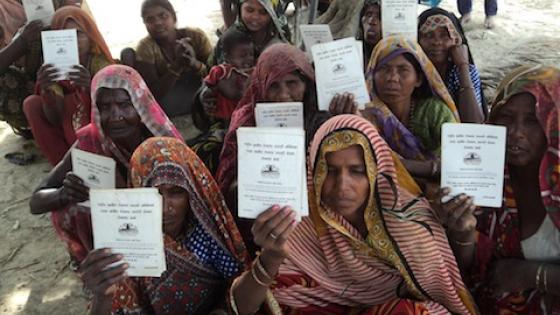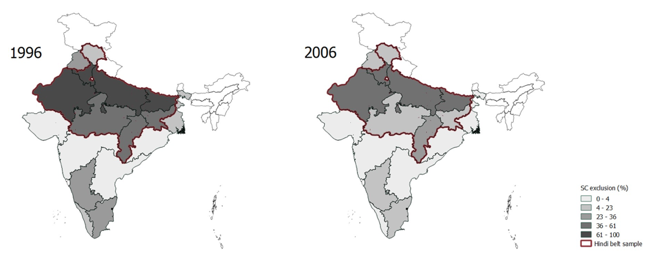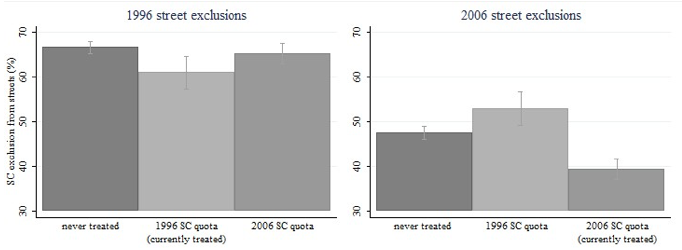More than 100 countries implement affirmative action under the form of electoral quotas for women, and 38 countries have electoral quotas for other minority groups (Krook 2009, Reynolds 2005). The objective is typically to repeal quotas once they have allowed the society to reach a non-discriminatory equilibrium. What may be the legacy of such a transitory quota? The redistributive effect of electoral quotas is subject to debate (Besley et al. 2004, Jensenius 2015). Alternatively, quotas are also likely to have long lasting effects if they change the way that people interact with each other.
In my recent research, I first investigate whether affirmative action, in the form of electoral quotas, affects caste-based discrimination in India (Girard 2018). I then document the channels linking electoral quotas and everyday discrimination.
Measuring caste-based discrimination through exclusion from streets
Discrimination is notoriously difficult to measure. I am able to overcome this difficulty thanks to exceptional features of the Indian setting. I exploit a question from the Rural Economic and Development Survey asking households whether they were excluded from some streets because of their caste in the years 1996 and 2006. In India, members of the marginalised Scheduled castes still face widespread discrimination (see the variation across states in Figure 1).
The change in declarations of exclusion from public goods (in this case, streets) provides an original proxy of discrimination, which is interesting for two main reasons. First, since streets are a public good, street exclusion proxies taste-based discrimination, the form of discrimination which is costly to society (Becker 1957).1 Second, in line with the plea in Bertrand and Duflo (2016), even imperfect measures of absolute discrimination remain useful to evaluate changes induced by anti-discriminatory interventions.
Figure 1 Street exclusion declarations by members of the Scheduled castes in 1996 and 2006
Note: The figure displays the average rate of street exclusion for SC households within each State in 1996 and 2006. The Hindi belt sample encompasses 40,047 households spread over 95 villages. The national sample encompasses 115,000 households from 242 villages.
Electoral quotas in India: A quasi-natural experiment
Electoral quotas are one of the most prominent policies implemented to fight caste-based discrimination in India. Members of the Scheduled castes, and other marginalised groups, benefit from quotas in the form of seat reservations in local political council (the Gram Panchayats). I focus the analysis on quotas for the seat of pradhans, the head the political council. Quotas rotate at each election, every five years, and are allocated by each state administration.
To investigate the impact of quotas on discrimination, I exploit the rotation of quotas across villages and the heterogeneity of the effects of quotas on households from different castes. Such a setting allows one to estimate a triple difference to investigate how everyday discrimination responds to quotas based on variation within village, caste, and respondents.
Ongoing quotas do decrease everyday discrimination
Ongoing Scheduled caste quotas appear to reduce caste-based discrimination. In Figure 1, members of the Scheduled castes declare significantly less street exclusion the year there is a Scheduled caste quota in their village (that is, the year that they are ‘treated’ by the quota). In the triple difference estimation, Scheduled caste quotas decrease street exclusions by about 10 percentage points for the households of the Scheduled castes. However, the effect is not permanent – it vanishes once the quota comes to an end. To put things in perspective, since roughly every second household reports exclusion in the Scheduled caste sample of the Hindi belt, ongoing quotas decrease the likelihood of street exclusion by about one fifth.
Figure 2 Scheduled caste street exclusion declarations according to quota attributions
Note: The figure displays the average rate of street exclusion for SC households and its confidence interval (at 95%) in different villages of the Hindi belt and for different years.
The channels through which quotas reduce discrimination
The electoral representation imposed through political quotas may affect people’s actions and inter-group relations through different channels. These channels rest on three key players: the political leader (who comes from the minority group), the members of the minority group, or the majority. A minority leader can improve access to public goods for her peers through construction, improved service, or network effects (Besley et al. 2004, Iyer et al. 2012, Gille 2018). As for the minority members, quotas can affect either the probability that they will voice their concerns, or their within-group solidarity, aspirations, or feelings of legitimacy (Hirschman 1970, Dunning 2010, Beaman et al. 2012, Iyer et al. 2012). Turning to members of the majority, exposition to a political leader from the minority can affect their personal stereotypes, meaning a private cognitive bias toward members of the minority (Beaman et al. 2009). Exposition to a leader from the minority can also change the perception of norms of public interactions, that is, whether it is appropriate to discriminate publicly against minority members, at a given level of cognitive bias (Chauchard 2014).
Given the temporary impact of quotas on discrimination, two channels appear to be consistent with the temporary decrease in discrimination that I observe during Scheduled caste quotas:
- either the minority leader plays a pivotal role while in office (enforcing or negotiating a change of behaviour of members of the dominant castes),
- or there is a change in the perception of the social norm by members of the dominant castes.
In both cases, members of the dominant castes change their behaviour for the duration of the electoral term, which is consistent with a reduction of street exclusions during Scheduled caste quotas. However, the transitory nature of the reduction of discrimination is inconsistent with alternative channels, which would lead to changes that are more persistent.
Auxiliary results are consistent with the leader or social norm channels, and inconsistent with alternative channels such as a change in the stereotypes held by members of the dominant castes, or a change in the aspirations of members of the lower castes. Indeed, Scheduled caste quotas have a significant effect on street exclusions only after the end of the second year of the implementation of the quota. This delayed effect is not consistent with the immediate update in aspirations observed in field experiments (Hoff and Pandey 2006). Moreover, the quotas do not improve members of the Scheduled castes’ perception of caste-based discrimination on the job market. These results are inconsistent with a change in the non-Scheduled caste households’ stereotypes because, if stereotypes evolve, they should do so in both the public sphere (street exclusions) and the private sphere (work-related interactions). For the same reason, these results are hard to reconcile with an interpretation of the variable of exclusion from streets as a measure of respondents’ perceptions of their legitimacy, independently of the actions of members of the dominant castes.
Conclusion
Overall, affirmative action policies allow for a big push toward reducing discriminatory practices. I document that ongoing electoral quotas reduce the practice of everyday caste-based discrimination by about one fifth. A one-shot quota is already enough to observe this effect. However, a one-time electoral quota does not appear to be enough to affect stereotypes and aspirations – the reduction in discriminatory practices is transitory and tied to the ongoing quota.
References
Beaman, L, R Chattopadhyay, E Duflo, R Pande and P Topalova (2009), “Powerful women: Does exposure reduce bias?”, Quarterly Journal of Economics 124(4): 1497–1540.
Beaman, L, E Duflo, R Pande and P Topalova (2012), “Female leadership raises aspirations and educational attainment for girls: A policy experiment in India”, Science 335(6068): 582–586.
Becker, G S (1957), The economics of discrimination, University of Chicago Press, Chicago.
Bertrand, M and E Duflo (2016), “Field experiments on discrimination”, NBER Working Paper 22014.
Besley, T, R Pande, L Rahman and V Rao (2004), “The politics of public good provision: Evidence from Indian local governments”, Journal of the European Economic Association 2(2-3): 416–426.
Chauchard, S (2014), “Can descriptive representation change beliefs about a stigmatized group? Evidence from rural India”, American Political Science Review 108(02): 403–422.
Dunning, T (2010), “Do quotas promote ethnic solidarity? Field and natural experimental evidence from India” Yale University, working paper.
Gille, V (2018), “Applying for social programs in India: Roles of local politics and caste networks in affirmative action”, Journal of Comparative Economics 46(2): 436–456.
Girard, V (2018), “Don’t touch my road: Evidence from India on affirmative action and everyday discrimination”, World Development 103(C): 1-13.
Hirschman, A (1970), Exit, voice, and loyalty: Responses to decline in firms, organizations, and states, ACLS Humanities E-Book, Harvard University Press.
Hoff, K and P Pandey (2006), “Discrimination, social identity, and durable inequalities”, American Economic Review 96(2): 206–211.
Iyer, L, A Mani, P Mishra and P Topalova (2012), “The power of political voice: Women’s political representation and crime in India”. American Economic Journal: Applied Economics 4(4): 165–93.
Jensenius, F R (2015), “Development from representation? A study of quotas for the scheduled castes in India”, American Economic Journal: Applied Economics 7(3): 196–220.
Krook, M L (2009), Quotas for women in politics, Oxford University Press.
Reynolds, A (2005), “Reserved seats in national legislatures: A research note”, Legislative Studies Quarterly 30(2): 301–310.
Endnotes
[1] Discriminatory agents are willing to pay – be it in money or time – to exclude other agents. This willingness to pay is the reason why taste-based discrimination induces an economic loss for the society (Becker 1957). Taste-based discrimination thus fundamentally differs from statistical discrimination whereby one could see discrimination as a screening device in the presence of imperfect information (Arrow 1973).





